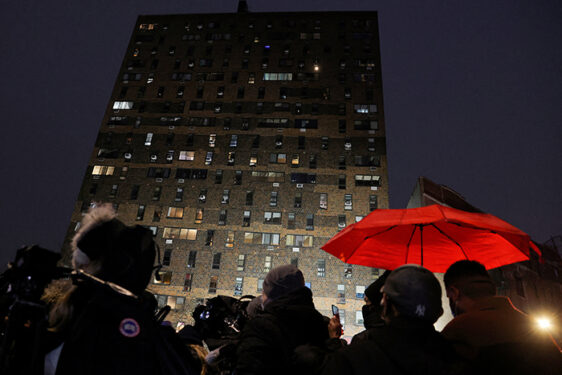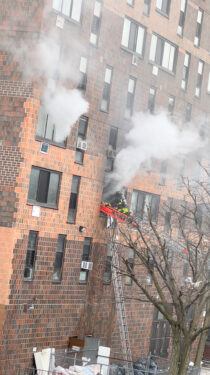
PROSPECT HEIGHTS — Public safety officials say smoke inhalation, not burns, killed at least 17 people, including eight children, and injured dozens in a Bronx apartment building fire Sunday, Jan. 9.
The blaze that ravaged the 120-unit building at 333 East 181st St. in the Fordham Heights neighborhood was among the worst in recent decades, according to New York City Fire Commissioner Daniel Nigro.
“The [fire] marshals have determined through physical evidence and through first-hand accounts by the residents that this fire started in the bedroom, in a portable electric heater,” Nigro said at a press conference Monday.
But, the commissioner added, the apartment’s door did not shut on its own in accordance with city safety codes.
“Unfortunately, the smoke spread throughout the building,” according to Mayor Eric Adams. “Thus, tremendous loss of life and other people fighting for their lives right now in hospitals all over the Bronx.”
As fire marshals continued their investigation, safety experts commented how smoke often is more harmful to people than flames.
“That’s not unusual,” said safety consultant James Bullock, a retired FDNY deputy chief. “Everything in an apartment burns — chairs, upholstery, rugs, wallpaper — everything will burn.
“Plastics today are in a lot of things, which produces a lot of smoke. But the plastics have their own toxicity.”
Bullock is co-owner and president of NY Fire Consultants.
He explained that modern high-rise buildings are usually made of concrete and steel.
Also, modern apartment units are built to contain a fire at its source.
A building designed this way is classified as “fireproof,” Bullock said.

Bullock advised that tenants should learn whether their building is fireproof or combustible because that determines if they should stay put or flee in the event of a fire. A building with walls, flooring, and roofs made of wood — typically “pre-war” structures from the mid-to-early 1940s and older — are classified as “combustible.” In such cases, the entire building is flammable, and in the event of a significant fire, occupants should evacuate immediately, according to Bullock.
But, he noted, “if it’s fireproof, it’s best to stay in your apartment — that is, if your apartment is not the one on fire.”
In such cases, it’s still best to not leave the apartment, even if some smoke is creeping through the door. Seal door jambs with wet rags or towels.
Also, slightly open the tops and bottoms of windows. Some residents in 333 East 181st Street reported that’s what they did.
“In this particular case, the fire never got out of the original apartment,” Bullock said.
Those killed or injured in the blaze left their apartments and went into the hallways where they encountered smoke that was unchecked by the open door where the fire started.
He also noted that every three years, the owner of a multiple-unit building is required to send out a “Fire Emergency Preparedness Guide” describing what to do in case of fire.
The City Council in 1999 passed an ordinance putting this fire-safety responsibility on building owners, Bullock said. It is now part of the city fire code.
“The first page of that thing tells you what the building is — combustible or fireproof,” Bullock said. “Read on further; it should tell you what to do in case of fire.”
The FDNY says owners of a building are required to post this document in a “conspicuous space in the common area.” They must also give a copy to new tenants “at the time of the lease.”
The Fire Department refers people to the New York City Buildings Department website, which has searchable databases on structures in all five boroughs.
Meanwhile, FDNY safety experts reiterate safety tips for any situation, such as regularly testing smoke and carbon monoxide detectors to ensure their batteries are sufficiently charged to sound an alert.
One public service announcement urges: “Closing the door behind you” while escaping a fire in an apartment, home, or business.”
When escaping a fire in your apartment, be #FDNYSmart – CLOSE THE DOOR as you make your exit. Closing the door saves lives. See more tips at https://t.co/NpwdRdlElY pic.twitter.com/vFFF0Oiyn9
— FDNY (@FDNY) January 10, 2022
“This will “trap the fire, prevent it from spreading and save lives,” the PSA states.
Another reminder is to never use an oven or stove to heat your home. As for space heaters, FDNY Lt. Tom McGarry says they present problems if not used correctly.
“If you’re using a space heater to stay warm, keep you and your family safe by keeping the space heater at least 3 feet away from bedding, curtains, and other materials,” he said. “Never use an extension cord with a space heater.”
He also urged people to turn off space heaters before leaving the room or going to sleep. “And remember,” Lt. McGarry concluded, “the use of kerosene or propane space heaters is illegal in New York City.”
Space heaters need space. Be #FDNYSmart – keep space heaters at least 3 ft. from bedding, curtains, and other materials, and always plug your heater directly into the wall. Learn more at https://t.co/NpwdRdlElY pic.twitter.com/eSpfdGujIf
— FDNY (@FDNY) January 10, 2022
Overall, it is also important to have an escape plan, that you routinely practice, to help keep you and your family safe if a fire breaks out.
